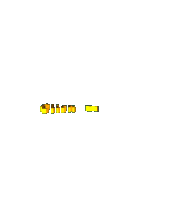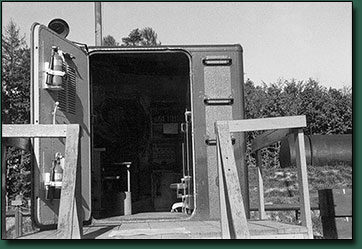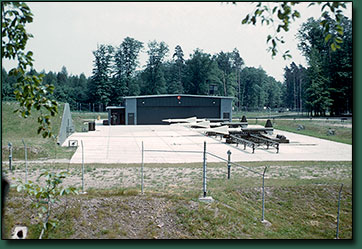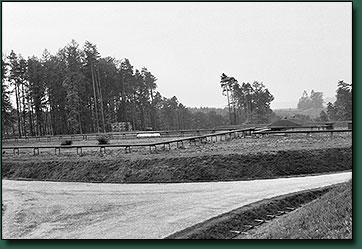

Charlie Battery - Kleingartach
The Launching Area - 1959 - 1969
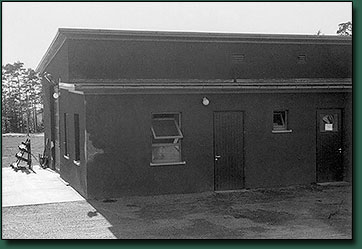 Assembly Building Close-up (Missile Maintenance)
Assembly Building Close-up (Missile Maintenance)
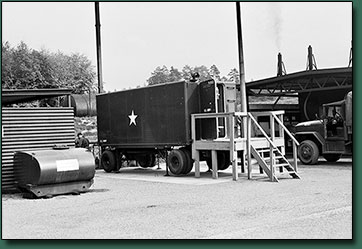 The LCT (Launcher Control Trailer) & Generator Building Overview
The LCT (Launcher Control Trailer) & Generator Building Overview
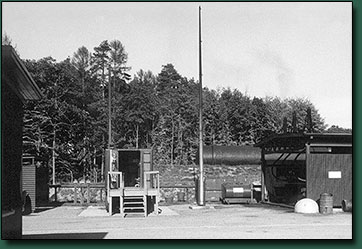 Overview Of The LCT And Generator Building
Overview Of The LCT And Generator Building
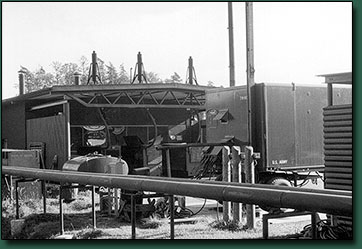 The Generator Building In Detail
The Generator Building In Detail
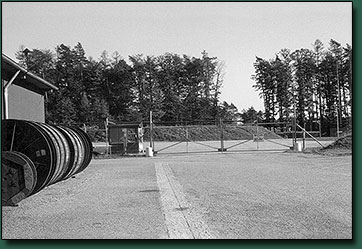 Launching Sections Main Security Gate W/Generator Building On The Left
Launching Sections Main Security Gate W/Generator Building On The Left
Just past the Generator Building is the left turn to take the road up and around Alpha Section back to the Launching Area's Main Gate.
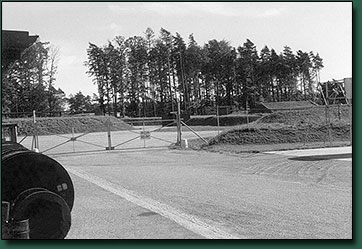 Detail Of Sections Main Perimeter Security Gate
Detail Of Sections Main Perimeter Security Gate
On the far left of the photo just above the cable spools is the Sections Inner Perimeter Security Guard Shack. There was a personnel gate entrance, as well as the main gate for vehicle access.
Just past the guard shack around and up the hill was Alpha Section. To the near right one can see the Revetment and Generator Shed of Bravo Section, and in the distance one can see the Missile Hanger of Charlie Section.
This is a perfect illustration of a Nike Launching Pad. Most launching sections that I have seen have 3 launchers each. The missiles roll across each launcher on rails that have sets of rollers both front and back, and move along tracks that go into the hanger where the Nike Hercules were stored. The tracks also extend out past the rear hanger door so missile trailers can pull up to on or off load other missiles. Images that illustrate that process can be seen at the bottom of Page 2 and on to Page 3. So please “Click Here” for those images.
In front of each missile on the concrete launching pad are 3 piles that are the folded missile covers to protect them from the weather and dirt in windy conditions. The covers are a heavy plastic sown into a shape the fit the missiles perfectly.
Also the revetment can be easily seen. Basically, it was a small protected room with hallways to the front, and out the back. A rear passage was necessary because the diesel electrical generator shed was behind the revetment, and during alerts every section fired up theirs up. Every area was electrically independent during alerts.
However my first Nike base, at the Hanford Nuclear Reservation in Washington State, had 4 launchers. This Nike base was a sophisticated and complex launching area that had a huge underground concrete missile storage area that brought missiles up and down on a huge elevator that had a launcher on it, which was the 4th launcher. So we could move missiles around on, as well as fire from that elevator.
It was a serious industrial device that had to travel quite a ways up to the surface. And when in the underground storage area, watching it elevate was fairly awesome sight, especially when the elevator reached its resting point on the surface. It had these massive locking devices slammed into the locking points on the elevator making crashingly loud din, painfully amplified by the cavernous space we were in.
A diagram of an underground storage area can be seen a PDF that explains the premise of a Nike Base and its various configurations. It helps one to have a more clear overview of a Nike Site. Please “Click Here” to view/download the article.
This road is part of the inner security service road to Alpha Section. If you turned around you would be looking at the section shown in the previous image. The fork to the left goes around to the back of the missile hanger, around passed the generator shed, and comes back to the place where I am standing. This is the road we walked our guard duty tours.
Looking across in the distance Bravo Section's revetment is to the left, and behind the trees to the right is Charlie Section. And if one continues down the road you come to the inner security gate on the right, or you can go left to Charlie Section.
One side note... While talking to Sgt. John Standerfer, former assistant Section Chief of Charlie Section 1968 era, he mentioned that while there something happen to Bravo Section rendering it unusable, but he never knew why.
Then a few weeks later while talking with Ron Daum of Alpha Section/LCT, see his “Guest Book” entry, and also of the 1968 era with Standerfer, told me the story of what happened to Bravo Section. It seems that while cutting the grass around the Section, using a German Lawn mower with the front rotating blade, someone put the mower down into the ditch where the cable were and seriously shredding thus severing them completely. I think probably at that point in time, when the Nike luster was waning, the brass concluded that Bravo Section wasn't worth fixing. Charlie Nike Battery later moved to Hardheim, about 70 Km. north, in 1969
Here is a detail of what I am talking about. The cables are using the ditch, suspended by wooden stringers, thus keeping them out of the running drain water. It's not like they couldn't be seen or avoided.“Click Here” to view the image.
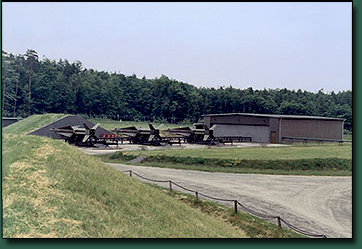 Alpha Section Hercules Rear View - 1968
Alpha Section Hercules Rear View - 1968
This actually a great view of Alpha Section and the relationship of the Missile hanger, launchers with missiles, and the crew revetment. Also, to the far left of the image, and out the back of the revetment one just see the Generator Shed.
Each section had its own diesel generator, which made them self sufficient and therefore not relying on an outside source for their electrical power needs.
When we had an alert the first task was to start the generator.


